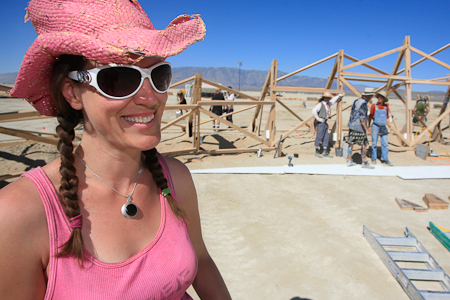
The Temple of Flux is being put in place in the far reaches of the playa, and it’s radically different than anything that has come before it. Not radical in the sense that it draws attention to itself by its differentness, but radical in its approach to and relationship with its environment.
Wooden panels will swoop and soar, and they’ll be clad in whitewashed wood. And the erected hills will create interior canyons, places for respite and reflection.
As it takes shape in the center of the Black Rock Desert, surrounded by rounded hills of many colors, the Temple seems to have found the place where it belongs. It is appropriate to the landscape, and man’s relationship with the desert vastness is re-emphasized by the Temple’s presence. Rather than usurp the terrain, the Temple seeks harmony with it.
It’s the biggest installation in artistic director Jess Hobb’s career. “It’s grandiose,” she says lightly, “but I also wanted to make it feel personal. I wanted people … not to feel small, but to feel connected to something larger.’’
The Temple is and always has been a place for haven and refuge, and perhaps this is the year that it is needed most. The 2010 theme of Metropolis connotes bustle and vibrancy and chaos and crowded anonymity. The Temple is the counterpoint to the constructed city; Metropolis is of man, the Temple is of nature. It seems meant to be here.
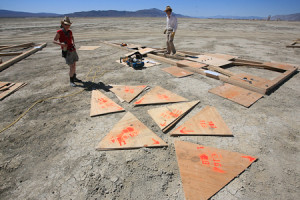 If you wandered off into the hills surrounding the Black Rock Desert, you’d soon be winding your way through the kinds of canyons that are being built in the Temple of Flux. Each of the Temple’s canyons is named — Bryce, Cayuaga, Dumont, Antelope and El Dorado. All of the places hold significance to various members of the Temple team, perhaps most notably Cayuaga, which is near Cornell, New York, where many members of the creative team attended school.
If you wandered off into the hills surrounding the Black Rock Desert, you’d soon be winding your way through the kinds of canyons that are being built in the Temple of Flux. Each of the Temple’s canyons is named — Bryce, Cayuaga, Dumont, Antelope and El Dorado. All of the places hold significance to various members of the Temple team, perhaps most notably Cayuaga, which is near Cornell, New York, where many members of the creative team attended school.
Hobbs received her Masters from the San Francisco Art Institute, where she lectures on the integration of social community and art. She is articulate and vivacious and whip-smart. She’s dressed all in pink, “kind of an inside joke,” poking fun at traditional notions of femininity.
Hobbs and her frequent collaborator Rebecca Anders installed “Fishbug” on the playa last year, but it was as they were returning from a visit to Dan Glass’ “Crow Mother” that she and Anders looked at each other and decided in that moment of excitement that, “We should do the Temple!” But a hectic schedule prevented them from committing to the project. That changed in mid-March, when the Burning Man Organization asked them to take on the job. They enlisted an architect for the project, Peter “PK” Kimmelman, and off they went.
“Where did we first start memorializing things?” Hobbs asks. “In canyons and caves.” So they incorporated the enduring Temple purpose of remembrance into an installation that would take its inspiration from the natural surroundings of the desert.
“There will be nooks and crannies of private space” throughout the Temple, Hobbs said, squinting at a three-dimensional model in the blazing heat and blinding midday sun.
Hobbs asked the Burning Man organization for the exact coordinates of the Temple’s placement before deciding on its final orientation. She wanted to make sure that people could take best advantage of what it had to offer. “Where’s the sun coming up,” she asks. “Where will people be able to sit and watch and reflect?”
There are 60 people on the worksite now, assembling 75 panels that are detailed in nearly a hundred pages of blueprints and instructions. The crew will continue to swell as the event approaches, eventually numbering approximately 120 people.
The preparatory work was done at American Steel in Oakland, and the first members of the construction crew arrived in the middle of last week. That was just a few days after PayPal tried to freeze funds donated to the Flux project, alleging that they had not provided sufficient information about their status as a non-profit. PayPal eventually allowed a one-time withdrawal and the account was drained, but late contributions will languish there until the legal matters are cleared up. (If you want to help make a dent in their sizable deficit, check on the best method for contributions at the group’s website here.
Hobbs seems happiest when she talks about the number of collaborators this project has required. “We’re not really size queens,” she says, laughing. Although she was involved with some of the outsized projects of the Flaming Lotus Girls, including the Serpent Mother, she seems matter-of-fact when explaining why this project became so large.
“It needed to be of a certain size to speak to its surroundings,” she says.
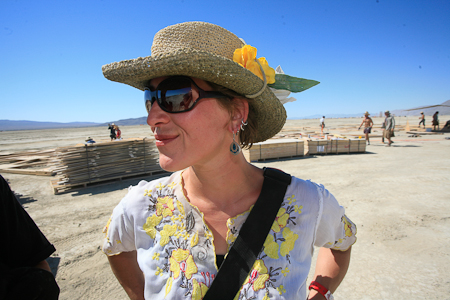
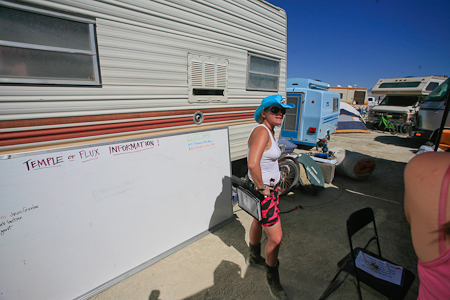
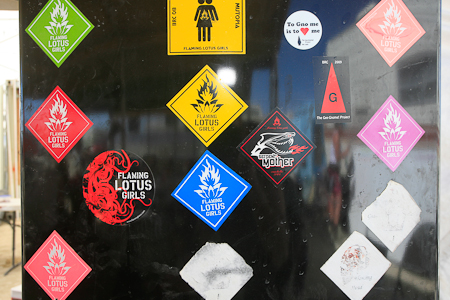
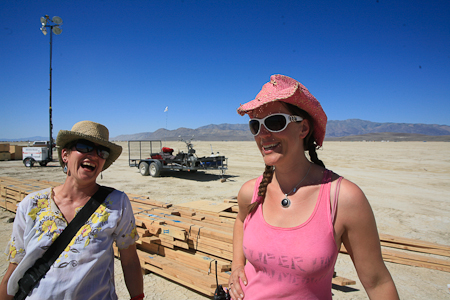
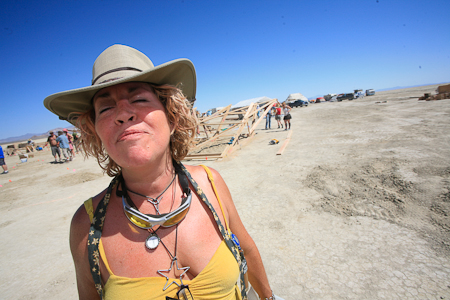

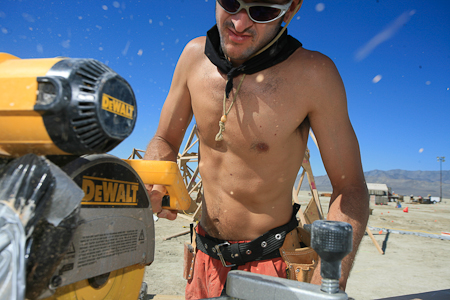
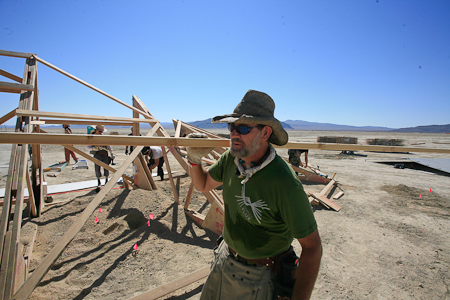
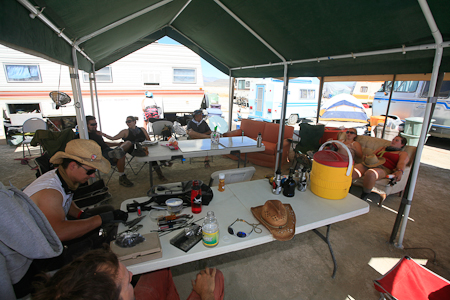
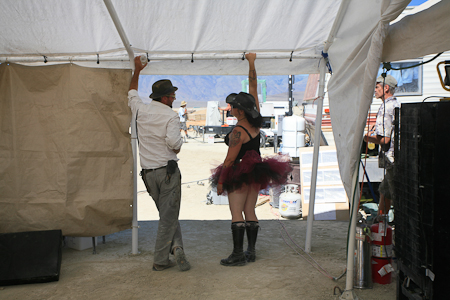
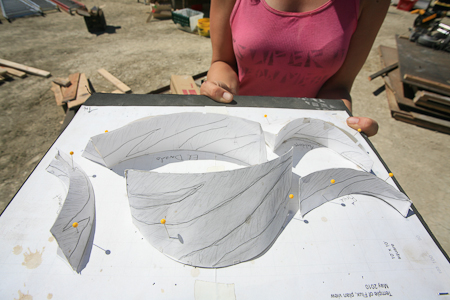

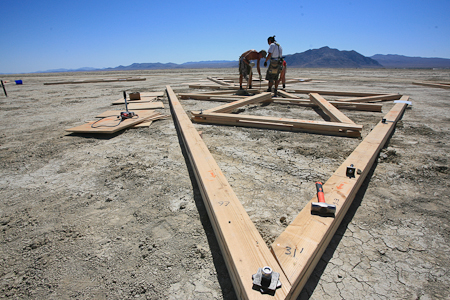
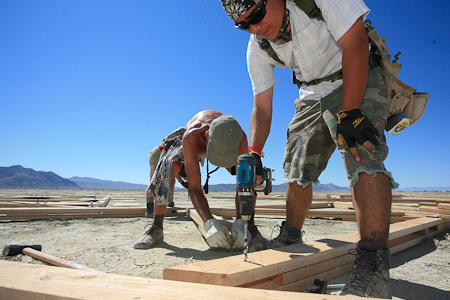

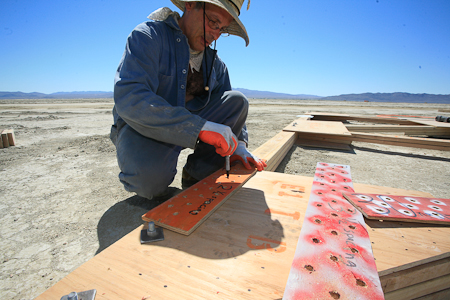
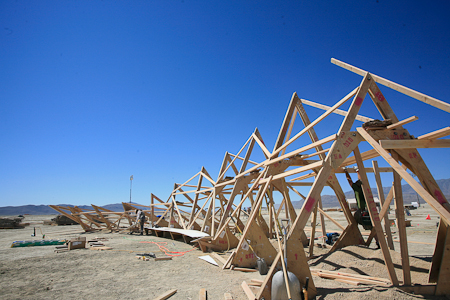
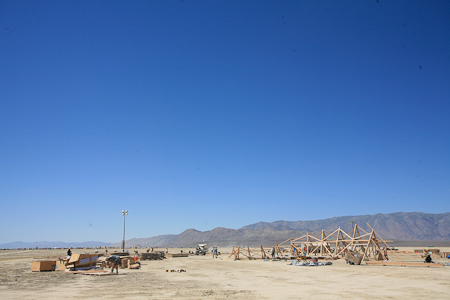

John, beautiful blog posts. I live living vicariously!!
please kiss Catie Magee and Elizabeth Marley for me. loves
Report comment
xoxo
Report comment
Your posts make my heart so happy! :)
Report comment
Such a wonderful gift for the people of Black Rock…
Report comment
This is the first year(of 5) that I have really been reading the blogs.. better late than never right?
They make me smile and tear up all at the same time. Cant wait to get out there this year.
<3
Report comment
So what ARE the coordinates of the Temple? I can’t wait to find it!
Report comment
You GO, fluxoids!! Lookin’ good, the build time is the best time to be on the playa you love. Congratulations in advance.
Report comment
I’m so glad to hear they got access to the PayPal funds! It looks like it’s going to be a gorgeous temple this year, and I can’t wait to experience it.
Report comment
Thank you so much for your coverage of the Temple of Flux.
A bit of clarification:
Cornell University is in Ithaca, NY, at the southern tip of Cayuga Lake, the largest of the Finger Lakes in upstate NY. Native folklore describes the Finger Lakes as the last place the Creator touched the Earth as it was sent spinning into existence.
Fluxers hail from tribes all over the playa, including the NeuroWeapon, Space Cowboys, and the Crucible. Donations greatly appreciated @ https://www.wepay.com/donate/start/5443, and more info on the Temple and the Flux Foundation is available @ Temple2010.org.
It’s gonna be great!
Report comment
Oh shoot, before you send the last comment I posted, I forgot, BRASS TAX!!!
Report comment
It has touched our souls, and it isn’t even done being built….
Report comment
Great job everyone!! Everyone is tooo clean!!! Thanks for all your hard work. My hubby is there with Support Services, Chicken Bone, hug him for me…. Mustang
Report comment
cant wait to see the temple. always an awesome place to just kick back and remember the loved once and meditate.
– pavit singh
Report comment
Awesome blog!
Regards to Gal K. :))
Report comment
BEAUTIFUL effort! You people are my heros!
Report comment
I’m not sure why but, this year seems to have an energy like no other years past….I read these updates, feel the excitment growing like never before….I can’t wait to get home!
Report comment
Sending my Chi and looking forward to soul-walk your creation! Thanks!
Report comment
:)
Report comment
I can’t wait to see it!!!! Thank you for your amazing work!
Report comment
Comments are closed.